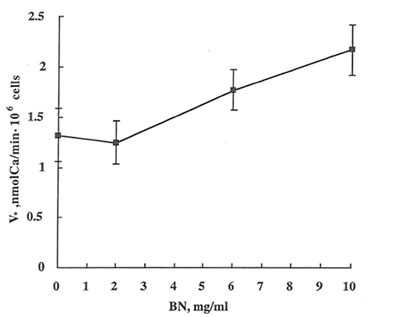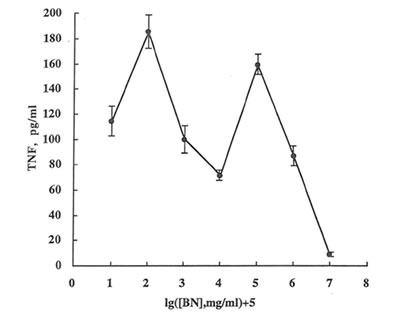| Title | PRELIMINARY STUDY OF BN ANTICANCER ACTIVITY |
|---|---|
| Year | |
| Author | |
| Publisher |
PRELIMINARY STUDY OF BN ANTICANCER ACTIVITY
(The effects of BN on the mobilization of intracellular calcium and TNF production)
Introduction
It is known that tumor necrosis factor (TNF) is a potent mediator of cytotoxic activity of macrophages and monocytes [1,2]. On the other hand, augmentation of phagocyte cytotoxic activity is known to be stimulated by the enhancement of intracellular calcium level [3]. Therefore, it is of outmost interest to study the effects of BN on the membrane permeability by calcium ions and the production of TNF by phagocytes because the augmentation of both processes by BN will indicate its potential anticancer activity.
Experimental
Determination of the rat macrophages permeability by calcium
Passive permeability of cellular membranes by calicium ions was studied by the introduction in the cells of florescent calcium indicator Quin 2AM [4]. Rat peritoneal macrophages were incubated with Quin 2AM (2 µM/106 cells) and BN at appropriate concentration in Ca-free HBSS at 37°C for 60 min. TI1en, the cells were twice rinsed and suspended in HBSS. The calcium efflux was started by the addition of 1 mM Ca ions. After measuring the initial rate of calcium incorporation, the cells were lysed with 0.05% Triton X-100, and the concentration of Quin-bounded Ca was determined. Fluorescence of Quin 2AM were registered on a Perkin-Elmer spectroflourimeter MPF-44a.
Measurement of TNF production by human blood monocytes
Human blood monocytes (2.5×106 cells/ml) were isolated using the modified Beutler method on a Ficol-Paque gradient (d= 1.077) and incubated with a soluble part of BN at appropriate concentration in a medium RPMI 1640 at 37°C for 1 hour. Then, the cells were centrifuge was washed with the same medium and incubated in medium RPMI 1640 supplied with 10% fetal calf serum in 24-viale planshet for 14 hours. The content of TNF in supernatant was determined using TNF –sensitive murine fibroblast cell line L929. The fibroblasts ware place in the 96vial planshet, and the supernatant was added in each vial. The content of unlysed fibroblasts was recorder by light scattering method staining of the viable cells with crystal violet dye. The absolute concentration of TNF in the supernatant was calculated in accord with calibration curve obtained with recombinant TNF-α in the concentration range of 16-1000 pg/ml.
Result and Discussion
It is seen that BN stimulates both Ca efflux into rat peritoneal macrophage (Fig.1) and TNF production by human blood monocytes (Fig.2). These finding suggest that BN must exhibit cytotoxic action against tumor cells that makes perspective further studies its anticancer activity
Reference
- P.J. Edelson., Monocytes and macrophages: aspects of their cell biology, in: Cell Biology of Inflammation Elsevier, Amsterdam, 470-495 (1980).
- L. Gagnon, L.G Filion, C. Dubois, and M.Rola-Pleszczynski, Leukotrienes and macrophage activation: Augmented cytotoxic activity and enhanced interleukin 1, tumor necrosis factor and hydrogen peroxide production. Agents Actions 26. 141-147 (1989).
- J.W. Putney; Stimulus-permeability coupling: role of calcium in the receptor regulation of membrane permeability, Pharm.Rev. 30, 209-245 (1979).
- J.S..Johansson and D.Haynes, Delibirate quin 2 overload as a method for in situ characte1ization of active calcium extrusion systems and cytoplasmic calcium binding: application of the human platelets, J.Memb.Biol. 104, 107-163 (1988).
Effect of BN on α-TNF production by human blood monocytes

